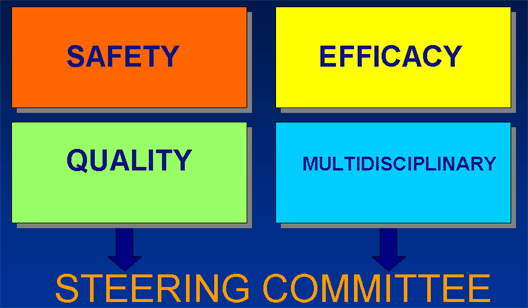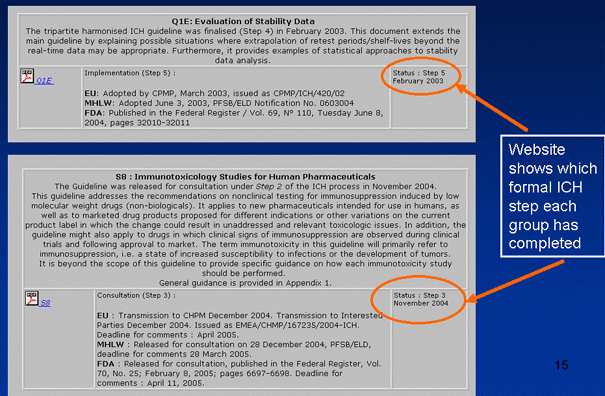CBER Presentation
Printable Version
Note: Documents in PDF format require the Adobe Acrobat Reader®. If you experience problems with PDF documents, please download the latest version of the Reader®.
The International Conference on Harmonization (ICH) and its Relevance to Cell Therapy
ISCT 6th Annual Somatic Cell Therapy Symposium
9/25-27/2006
Jennifer Catalano
Office of Cellular, Tissue and Gene Therapies
Center for Biologics Evaluation and Research
Food and Drug Administration
A Unique Approach
- ICH was created in 1990
- Agreement between the EU, Japan and the USA to harmonize different regional requirements for registration of pharmaceutical drug products
- Unique because joint effort by regulators and associated pharmaceutical industry trade associations
ICH Objectives
- Elimination of the need to duplicate studies to meet different regulatory requirements
- More efficient use of resources in the R&D process, as a consequence
- Quicker access for patients to safe and effective new medicines
Principles of ICH
- Development of scientific consensus documents through discussions between regulatory and industry experts
- Wide consultation of the draft consensus documents through normal regulatory channels before a harmonized text is adopted
- Commitment by regulatory parties to implement the ICH harmonized texts
STATEMENT BY THE ICH STEERING COMMITTEE
TOKYO 1990
- The Conference will not only look at existing issues but will, based on past experience, seek to minimize future divergence of new registration requirements, as a consequence of technical progress.
Who are the members?
- Founding members: Reps from the six co-sponsoring parties from the United States, the European Union, and Japan
- Observers: World Health Organization (WHO), the European Free Trade Area (EFTA), Canada (each observer has a seat on the steering committee as a non-voting member and participates in EWGs)
- The International Federation of Pharmaceutical Manufacturers Associations (IFPMA): represents 56 countries (non-voting member of SC and runs the ICH secretariat)
Six parties directly involved in the decision making process
- US Food and Drug Administration (FDA)
- Pharmaceutical Research and Manufacturers of America (PhRMA)
- European Commission - European Union (EU)
- European Federation of Pharmaceutical Industries and Associations (EFPIA)
- Ministry of Health, Labor and Welfare, Japan (MHLW)
- Japan Pharmaceutical Manufacturers Association (JPMA)
ICH Steering Committee
- Determines the policies and procedures for ICH
- Selects topics for harmonization
- Monitors the progress of harmonization initiatives
- Has two members for each of the six co-sponsors, the IFPMA and Observers
Harmonization topics divided into categories
SAFETY
EFFICACY
QUALITY
MULTIDISCIPLINARY
The harmonization output document is called a "guideline"
An ICH Guideline is FDA Guidance
Expert Working Groups

Monitors and Facilitates EWGs
An EWG has 6 Topic Leaders - one from each ICH party
Examples of Guidelines
Q1A(R2): Stability Testing of New Drug Substances and Products (Second Revision)
S1B: Testing for Carcinogenicity of Pharmaceuticals
E4: Dose-Response information to Support Drug Registration
M2: Electronic Standards for the transfer of regulatory information
How to become a bona fide guideline
PART 1: Initiation of Harmonization Action
1.1 Proposal channeled through co-sponsor or observer on SC
1.2 Preparation of Concept Paper
1.3 Selection of Procedure: Most go to Step 2, Maintenance of Existing Guidelines go to ICH Secretariat
PART 2: Full ICH Process for Major Harmonization Topics
2.1 Topic Selection
2.2 Steering Committee Action: Confirm Objectives & Outcome of Harmonization Action
2.3 Expert Working Groups
2.4 Timetable and Action Plan
2.5 Steps in ICH Process
Steps in the ICH Process
STEP 1. Consensus Building: Draft Guideline Circulated for Comment. Sign-off by EWGs.
STEP 2. Start of Regulatory Action: Steering Committee agrees there is scientific consensus to go to next step.
STEP 3. Regulatory Consultation: Guideline leaves ICH process for comments. In the USA it is published as a draft guidance in the Federal Register. Regulatory Rapporteur draws up final document.
STEP 4. Adoption of Tripartite Harmonized Text: SC receives document
Three Regulatory Parties sign to affirm it is recommended for adoption.
STEP 5. Implementation: Regulatory Actions taken and dates of implementation reported to SC & published by Secretariat.
Example Guidelines from ICH Website www.ich.org

Elements of a Concept Paper
- Type of action proposed: Is this a new guideline or amendment to an existing one?
- Perceived problem: In the case of a new field of science, consider problems if harmonization action is not taken
- Background information
- Type of Expert Working Group: Will the EWG be comprised of only the six-party group, or will the group be extended?
Relevance to Cell Therapy
- ICH is a forum for regulatory agreement from multiple countries
- Cell therapy specific guidelines have yet to be written
- The concepts from other harmonized guidelines are applicable to cell therapy, and it is important to have a vision of where quality, safety, and efficacy fit into a framework for successful treatment
Examples
- Q6B: Specifications: Test Procedures and Acceptance Criteria for Biotechnological/ Biological Products
- Q5D: Derivation and Characterization of Cell Substrates used for Production of Biotechnological/Biological Products
- Q5E: Comparability of Biotechnological/ Biological Products Subject to Changes in their Manufacturing Process
- S6: Preclinical Safety Evaluation of Biotechnology-Derived Pharmaceuticals


